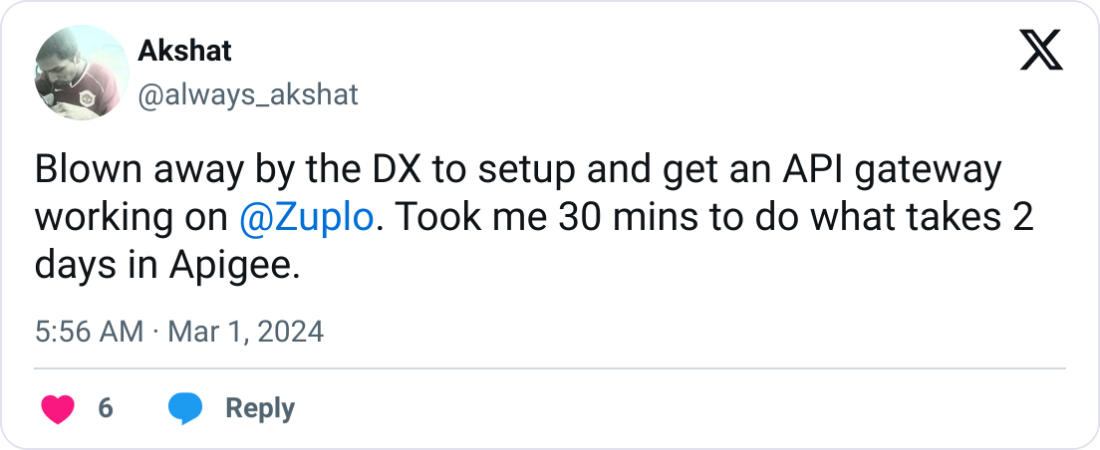As APIs become more critical, effective governance is essential to ensure quality, security, and consistency at scale. Without strong governance in place, organizations face challenges like inconsistent quality, security vulnerabilities, and costly rework. Embedding API governance directly into your DevOps pipelines allows teams to catch potential issues early—before they become expensive and time-consuming to fix. This proactive approach not only ensures smoother integrations but also boosts collaboration, enhances API quality, and improves overall security and reusability.
Whether you're scaling your API ecosystem or maintaining a growing number of services, having a robust governance strategy will ensure your APIs meet business needs while minimizing risk. Let’s dive into the essential components of API governance, explore practical implementation strategies, and discuss best practices tailored to your DevOps environment.
- What Is API Governance and Why Does It Matter?
- Creating an API Governance Framework
- Developing Your API Governance Framework
- Balancing Governance and Developer Autonomy
- Automating API Governance in CI/CD Pipelines
- Benefits of Automated Governance
- Key Performance Indicators for API Governance
- Best Practices When Using API Governance in DevOps Pipelines
- Creating a Governance-Oriented Culture
- Troubleshooting Common API Governance Challenges
- Investing in API Governance for Long-term Success
What Is API Governance and Why Does It Matter?#
API governance is a comprehensive framework of guidelines, standards, and procedures that ensure APIs are high quality, consistent, compliant, and aligned with business goals throughout their entire lifecycle. From design and development to deployment, management, and eventual retirement, governance defines the enterprise-wide rules and policies dictating how APIs should be used and managed.
Core Components of API Governance#
An effective API governance strategy includes several key elements:
- API coding standards and design style guides
- Security and API gateway policy enforcemen
- Business-level metadata for API discovery and consumption
- Access controls and user permissions, such as RBAC in API governance
- Standardized versioning approaches
- Documentation requirements
- Performance monitoring and observability practices
The Critical Importance of Governance#
You might wonder why implementing formal governance matters when your development teams are already productive. There are, in fact, several reasons:
- Quality and Consistency: Good governance ensures all APIs adhere to defined standards for design, security, and performance, promoting consistency across your API portfolio. This dramatically improves developer experience and enables reusability of API components.
- Compliance and Security: Strong API governance mitigates risks associated with API vulnerabilities and potential data breaches while enabling centralized control over API access and usage.
- Business Alignment: Properly governed APIs support your overall business strategy and objectives. Governance facilitates tracking API performance against business KPIs and enables strategic decision-making regarding API investments.
- Scalability and Efficiency: As your API ecosystem grows, governance reduces API sprawl and redundancy, facilitates easier integration between systems, and streamlines lifecycle management processes.
Governance in Modern DevOps Environments#
In fast-paced DevOps environments, understanding how to use API governance in DevOps pipelines is non-negotiable. By implementing automated checks and validations within CI/CD pipelines and embracing GitOps principles in API management, organizations can maintain quality and security without hindering agility.
Practices like version control, change impact analysis, and automated testing ensure API quality throughout rapid development cycles—all while ensuring they deliver real business value.
Creating an API Governance Framework#

An effective API governance framework helps establish guardrails for API development while ensuring business goals are met. Here’s how to set up your own.
Key Components of an API Governance Framework#
A comprehensive API governance framework consists of four primary elements:
- Policies
- API design standards and guidelines that ensure consistency across endpoints
- Security and compliance requirements to protect data and meet regulatory needs
- API versioning guidance to manage API lifecycle and changes
- Documentation standards for clear communication to API consumers
- API lifecycle management policies for API retirement and deprecation
- Procedures
- API review and approval process to ensure quality standards
- Change management procedures to handle updates
- Monitoring and analytics procedures to track API performance and monitor role-based access control
- Incident response procedures for handling issues
- Deprecation and retirement procedures to smoothly sunset old APIs
- Tools
- API catalog/registry to maintain visibility across your API portfolio
- API design and documentation tools like Swagger/OpenAPI
- Hosted API gateway advantages for centralized policy enforcement
- Monitoring and analytics platforms for usage insights
- Automated governance checks and validations
- Roles
- API governance team/committee to oversee the framework
- API product owners responsible for specific APIs
- API developers who build and maintain the interfaces
- Security and compliance officers to ensure protection standards
- Business stakeholders to align APIs with business objectives

Over 10,000 developers trust Zuplo to secure, document, and monetize their APIs
Learn MoreDeveloping Your API Governance Framework#
Follow these steps to build a tailored governance framework for your organization:
- Identify Key Stakeholders and Form a Governance Team
Begin by assembling representatives from IT, security, and business units. Appoint a dedicated governance lead or champion who can drive the initiative forward. - Assess Current API Landscape
Take inventory of existing APIs, evaluate current practices, and identify gaps in your governance approach. - Define Governance Objectives and Scope
Align your governance framework with your overall API strategy and business goals. Determine which APIs and teams will fall under the governance umbrella. - Establish Core Policies and Standards
Draft detailed guidelines covering API design, security requirements, documentation standards, and versioning policies. These become the foundation of your governance framework. - Design Governance Processes
Create workflows for API review and approval, change management, and monitoring procedures that help enforce your policies. - Select and Integrate Governance Tools
Choose appropriate tools for your API catalog, design and documentation platforms, API gateways, and monitoring solutions to automate governance where possible. - Define Roles and Responsibilities
Clearly assign ownership for different governance areas and establish decision-making authority within your organization. - Develop Training and Enablement Plan
Create documentation, guides, and training sessions to ensure all team members understand and can follow governance requirements. - Build Implementation Roadmap
Prioritize your governance initiatives, set realistic timelines and milestones, and allocate necessary resources. - Establish Feedback Mechanisms
Create regular governance reviews and channels for team input to continuously improve your framework.
Example Governance Policies#
To bring your framework to life, here are some specific policy examples:
- API Naming Convention: Use lowercase, hyphen-separated names for API
resources (e.g.,
/user-accounts) to maintain consistency across your API ecosystem. - Versioning Policy: Implement semantic versioning (MAJOR.MINOR.PATCH) in the API headers to clearly communicate API changes to consumers.
- Security Policy: Require all APIs to use OAuth 2.0 for authentication and TLS 1.2+ for encryption to protect data in transit.
- Documentation Requirement: Mandate that all APIs have complete OpenAPI/Swagger documentation before production deployment to ensure usability.
- Review Process: Require new APIs and major changes to undergo review by the governance committee before approval to maintain quality standards.
- Monitoring Standard: Ensure all APIs integrate with your central monitoring platform for performance and error tracking to enable proactive management.
- Deprecation Policy: Support APIs for at least 12 months after a deprecation notice is given to provide consumers adequate transition time.
Balancing Governance and Developer Autonomy#
Finding the right balance between governance and developer autonomy represents one of the most significant challenges in API development. And, according to research from Skyline, organizations that fail to find this balance often experience either significant delays in shipping features or increasing system quality issues over time.
To address this, organizations can implement several key strategies:
- Adaptive Governance: A good policy is to distribute decision-making across teams while maintaining global policies. Platform Operations teams establish overarching guidelines, while API teams handle local implementation details.
- Clear Service Boundaries: Breaking systems into distinct modules or microservices gives teams full ownership over their domains while reducing dependencies and conflicts.
- API Contracts: Establishing stable, well-defined API contracts between services allows teams to update internal implementations without breaking others' work.
- Self-Service Infrastructure: Providing developers with access to CI/CD, testing, and monitoring tools enables independent deployment and management.
- Continuous Refactoring: Addressing technical debt regularly rather than in large overhauls keeps systems clean while allowing continuous feature delivery.
Automating API Governance in CI/CD Pipelines#

API governance shouldn't be a manual, time-consuming process. By integrating testing directly into your CI/CD pipelines, you can ensure consistent quality, security, and compliance throughout your API lifecycle while maintaining development velocity.
Key Aspects of API Governance to Automate#
Several critical elements of API governance lend themselves well to automation:
- API design validation against your organizational standards and style guides
- Security checks, including authentication and authorization mechanisms
- Performance testing to ensure APIs meet service-level objectives
- Compliance verification with internal policies and external regulations
- API documentation generation and validation
- Versioning enforcement
- Rate limiting configuration
Automation Tools and Integration Examples#
To implement automated governance, you'll need the right tools integrated into your pipeline:
- Spectral: This open-source API linting tool validates API definitions against your standards. In a Jenkins pipeline, you can add a stage to run Spectral against OpenAPI specs before deployment is allowed to proceed.
- SonarQube: Integrate this tool for static code analysis that identifies security vulnerabilities in your API code as part of a GitLab CI job.
- JMeter: Automated performance testing can be executed as an Azure DevOps pipeline task to verify your APIs meet performance requirements.
- Dredd: This tool validates your API implementation against your API documentation, ensuring the two remain in sync as part of your pipeline checks.
Benefits of Automated Governance#
Want to know why automated API governance in DevOps pipelines is a total game-changer? Here's the deal:
- Consistent enforcement: Policies are applied uniformly across all APIs, eliminating the variability of manual reviews.
- Early issue detection: Problems are caught during development rather than in production, saving time and resources.
- Reduced manual effort: Automation eliminates repetitive tasks and human error, freeing your team to focus on more valuable work.
- Rapid feedback: Developers receive immediate governance feedback, allowing for quicker remediation.
- Scalable governance: As your API portfolio grows, automated governance scales efficiently without proportional increases in overhead.
Key Performance Indicators for API Governance#
Tracking the right metrics is crucial for measuring the effectiveness of your governance program. Here are some essential KPIs to consider:
Operational KPIs:
- API uptime/availability
- Error rates
- Response times
- Number of security incidents
- Percentage of APIs passing compliance checks
Adoption and Business KPIs:
- Number of API consumers/subscribers
- API usage growth rate
- Developer satisfaction score
- Revenue generated through APIs
- Cost savings from API reuse
Best Practices When Using API Governance in DevOps Pipelines#
Effective API governance isn't something you bolt on after development—it needs to be woven throughout the entire API lifecycle. Organizations that excel at API governance apply it strategically at every stage, from design to retirement.
Implementing Governance Throughout the API Lifecycle#
To maximize the benefits of API governance, you should apply it at all the stages of your API's existence.
- Design Phase Governance: The first essential phase sets the foundation for everything that follows. During design, establish clear standards for documentation, versioning schemes, and consistent API styles that align with your organization's needs.
- Development Phase Controls: When developers are coding, enforce standards and security measures that prevent vulnerabilities from being introduced. This is where automated code analysis proves invaluable.
- Testing Governance: Standardized test cases and compliance checks during this phase catch issues before they affect production systems or customers.
- Deployment Guardrails: Ensure your deployment processes maintain consistent artifacts and appropriate policies that protect your production environment.
- Consumption Governance: Once APIs are available, implement usage monitoring and access controls that prevent abuse while maintaining availability.
- Evolution Management: Conduct thorough impact analysis before changes and maintain clear communication channels with consumers who rely on your APIs.
Specific API Governance Best Practices#
We recommend establishing a centralized set of enterprise-wide API governance rules that include:
- Basic coding standards like OpenAPI Specification
- Rules based on legal and regulatory requirements
- API basepath uniqueness requirements
- Metadata fields for discoverability (owner, lifecycle state, etc.)
- Access control rules
However, it's equally important to build in flexibility and clear exception pathways. Not all APIs should be governed identically. Consider applying different governance levels based on API type, use case, or owner.
Another powerful practice is to leverage an API catalog that captures all APIs across lifecycle states and platforms. This catalog becomes your single source of truth for tracking governance compliance, identifying risks that need remediation, and monitoring governance KPIs over time.
Don't forget to prioritize API security throughout the lifecycle. This includes incorporating authentication, authorization, access controls, and encryption. Many organizations utilize API gateways to enhance security controls and protect against cyber threats.
Addressing API Governance Obstacles and Resistance#
Despite the clear benefits, you'll likely encounter resistance to API governance. Common challenges include the perception of governance as slow and manual, difficulty enforcing rules without rigid approval flows, and resistance to centralized control.
To overcome these obstacles, focus on empowerment and enablement rather than enforcement. Automate governance processes to increase speed and productivity, and provide clear exception pathways for flexibility.
Creating a Governance-Oriented Culture#
Shifting your organization's perspective on governance from a constraining set of rules to an enabling framework is essential for sustainable success. A governance-oriented culture views oversight not as red tape but as a foundation for better decision-making and operational excellence.
When you foster this mindset, you'll see several tangible benefits. Research shows that a strong governance culture enhances organizational performance and sustainability while building trust with key stakeholders including employees, customers, and investors. Additionally, it improves decision-making processes and significantly reduces risks and potential misconduct.
To create this culture, consider implementing these key initiatives:
- Leadership Commitment: Ensure leaders visibly champion governance principles and integrate them into strategic planning.
- Employee Training: Provide regular governance education with role-specific training on responsibilities.
- Clear Frameworks: Develop accessible, easy-to-understand governance policies and procedures.
- Cross-Functional Committees: Form diverse teams to oversee governance initiatives and rotate membership to broaden perspectives.
Troubleshooting Common API Governance Challenges#
When implementing API governance, you'll likely encounter several common obstacles. Being prepared with practical solutions can save significant time and resources.
Lack of Centralized API Inventory#
Organizations often struggle to maintain visibility across all their APIs, resulting in redundancy and security risks. Combat this by implementing a centralized API catalog and using automated discovery tools to identify existing APIs.
Inconsistent API Design#
When different teams develop APIs without standardization, integration complexity increases and developer experience suffers. Establish clear design guidelines and implement linting tools to automatically verify compliance with standards.
Security Vulnerabilities#
APIs can introduce significant security risks when not properly secured. Implement robust authentication mechanisms, conduct regular security audits, and use API gateways to enforce consistent security policies.
Versioning Challenges#
Managing API changes and deprecation often proves difficult. Establish clear semantic versioning strategies, implement proper change management processes, and provide deprecation schedules with migration paths for consumers.
Investing in API Governance for Long-term Success#
Effective API governance delivers concrete benefits: enhanced security, improved standardization, reduced redundant development, and better regulatory compliance. The way to achieve it? Stack your approach. Strong standards + automated enforcement + clear communication = chef's kiss 👨🍳
To accelerate your governance journey, consider a purpose-built solution like Zuplo. Our platform provides the comprehensive policy enforcement, security controls, and monitoring capabilities you need to implement governance at scale—without slowing down your development teams. Request a demo to see how Zuplo can help you implement effective governance while accelerating your API initiatives.